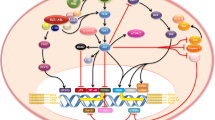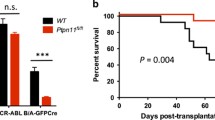Abstract
BCR/ABL is the causative agent of chronic myelogenous leukemia (CML). Through structure/function analysis, several protein motifs have been determined to be important for the development of leukemogenesis. Tyrosine177 of BCR is a Grb2 binding site required for BCR/ABL-induced CML in mice. In the current study, we use a mouse bone marrow transduction/transplantation system to demonstrate that addition of oncogenic NRAS (NRASG12D) to a vector containing a BCR/ABLY177F mutant “rescues” the CML phenotype rapidly and efficiently. To further narrow down the pathways downstream of RAS that are responsible for this rescue effect, we utilize well-characterized RAS effector loop mutants and determine that the RAL pathway is important for rapid induction of CML. Inhibition of this pathway by a dominant negative RAL is capable of delaying disease progression. Results from the present study support the notion of RAL inhibition as a potential therapy for BCR/ABL-induced CML.
Similar content being viewed by others
References
Rowley JD. Letter: a new consistent chromosomal abnormality in chronic myelogenous leukaemia identified by quinacrine fluorescence and Giemsa staining. Nature 1973; 243(5405): 290–293
Groffen J, Stephenson JR, Heisterkamp N, de Klein A, Bartram CR, Grosveld G. Philadelphia chromosomal breakpoints are clustered within a limited region, bcr, on chromosome 22. Cell 1984; 36(1): 93–99
McWhirter JR, Galasso DL, Wang JY. A coiled-coil oligomerization domain of Bcr is essential for the transforming function of Bcr-Abl oncoproteins. Mol Cell Biol 1993; 13(12): 7587–7595
Zhang X, Subrahmanyam R, Wong R, Gross AW, Ren R. The NH (2)-terminal coiled-coil domain and tyrosine 177 play important roles in induction of a myeloproliferative disease in mice by Bcr-Abl. Mol Cell Biol 2001; 21(3): 840–853
Cortez D, Kadlec L, Pendergast AM. Structural and signaling requirements for BCR-ABL-mediated transformation and inhibition of apoptosis. Mol Cell Biol 1995; 15(10): 5531–5541
Lugo TG, Pendergast AM, Muller AJ, Witte ON. Tyrosine kinase activity and transformation potency of bcr-abl oncogene products. Science 1990; 247(4946): 1079–1082
He Y, Wertheim JA, Xu L, Miller JP, Karnell FG, Choi JK, Ren R, Pear WS. The coiled-coil domain and Tyr177 of bcr are required to induce a murine chronic myelogenous leukemia-like disease by bcr/abl. Blood 2002; 99(8): 2957–2968
Million RP, Harakawa N, Roumiantsev S, Varticovski L, Van Etten RA. A direct binding site for Grb2 contributes to transformation and leukemogenesis by the Tel-Abl (ETV6-Abl) tyrosine kinase. Mol Cell Biol 2004; 24(11): 4685–4695
Sattler M, Mohi MG, Pride YB, Quinnan LR, Malouf NA, Podar K, Gesbert F, Iwasaki H, Li S, Van Etten RA, Gu H, Griffin JD, Neel BG. Critical role for Gab2 in transformation by BCR/ABL. Cancer Cell 2002; 1(5): 479–492
Goga A, McLaughlin J, Afar DE, Saffran DC, Witte ON. Alternative signals to RAS for hematopoietic transformation by the BCR-ABL oncogene. Cell 1995; 82(6): 981–988
Million RP, Van Etten RA. The Grb2 binding site is required for the induction of chronic myeloid leukemia-like disease in mice by the Bcr/Abl tyrosine kinase. Blood 2000; 96(2): 664–670
Campbell SL, Khosravi-Far R, Rossman KL, Clark GJ, Der CJ. Increasing complexity of Ras signaling. Oncogene 1998; 17(11 Reviews): 1395–1413
Deininger MW, Goldman JM, Melo JV. The molecular biology of chronic myeloid leukemia. Blood 2000; 96(10): 3343–3356
White MA, Nicolette C, Minden A, Polverino A, Van Aelst L, Karin M, Wigler MH. Multiple Ras functions can contribute to mammalian cell transformation. Cell 1995; 80(4): 533–541
Campbell PM, Singh A, Williams FJ, Frantz K, Ulkü AS, Kelley GG, Der CJ. Genetic and pharmacologic dissection of Ras effector utilization in oncogenesis. Methods Enzymol 2006; 407: 195–217
Leicht DT, Balan V, Kaplun A, Singh-Gupta V, Kaplun L, Dobson M, Tzivion G. Raf kinases: function, regulation and role in human cancer. Biochim Biophys Acta 2007; 1773(8): 1196–1212
Roberts PJ, Der CJ. Targeting the Raf-MEK-ERK mitogen-activated protein kinase cascade for the treatment of cancer. Oncogene 2007; 26(22): 3291–3310
Rodriguez-Viciana P, Warne PH, Khwaja A, Marte BM, Pappin D, Das P, Waterfield MD, Ridley A, Downward J. Role of phosphoinositide 3-OH kinase in cell transformation and control of the actin cytoskeleton by Ras. Cell 1997; 89(3): 457–467
Downward J. Targeting RAS signalling pathways in cancer therapy. Nat Rev Cancer 2003; 3(1): 11–22
Albright CF, Giddings BW, Liu J, Vito M, Weinberg RA. Characterization of a guanine nucleotide dissociation stimulator for a ras-related GTPase. EMBO J 1993; 12(1): 339–347
Feig LA. Ral-GTPases: approaching their 15 minutes of fame. Trends Cell Biol 2003; 13(8): 419–425
White MA, Vale T, Camonis JH, Schaefer E, Wigler MH. A role for the Ral guanine nucleotide dissociation stimulator in mediating Rasinduced transformation. J Biol Chem 1996; 271(28): 16439–16442
Urano T, Emkey R, Feig LA. Ral-GTPases mediate a distinct downstream signaling pathway from Ras that facilitates cellular transformation. EMBO J 1996; 15(4): 810–816
Lim KH, O’Hayer K, Adam SJ, Kendall SD, Campbell PM, Der CJ, Counter CM. Divergent roles for RalA and RalB in malignant growth of human pancreatic carcinoma cells. Curr Biol 2006; 16(24): 2385–2394
Lim KH, Baines AT, Fiordalisi JJ, Shipitsin M, Feig LA, Cox AD, Der CJ, Counter CM. Activation of RalA is critical for Ras-induced tumorigenesis of human cells. Cancer Cell 2005; 7(6): 533–545
Chien Y, White MA. RAL GTPases are linchpin modulators of human tumour-cell proliferation and survival. EMBO Rep 2003; 4(8): 800–806
Parikh C, Subrahmanyam R, Ren R. Oncogenic NRAS rapidly and efficiently induces CMML- and AML-like diseases in mice. Blood 2006; 108(7): 2349–2357
Zhang X, Ren R. Bcr-Abl efficiently induces a myeloproliferative disease and production of excess interleukin-3 and granulocytemacrophage colony-stimulating factor in mice: a novel model for chronic myelogenous leukemia. Blood 1998; 92(10): 3829–3840
Tchevkina E, Agapova L, Dyakova N, Martinjuk A, Komelkov A, Tatosyan A. The small G-protein RalA stimulates metastasis of transformed cells. Oncogene 2005; 24(3): 329–335
Omidvar N, Pearn L, Burnett AK, Darley RL. Ral is both necessary and sufficient for the inhibition of myeloid differentiation mediated by Ras. Mol Cell Biol 2006; 26(10): 3966–3975
Pear WS, Nolan GP, Scott ML, Baltimore D. Production of hightiter helper-free retroviruses by transient transfection. Proc Natl Acad Sci USA 1993; 90(18): 8392–8396
Gross AW, Zhang X, Ren R. Bcr-Abl with an SH3 deletion retains the ability to induce a myeloproliferative disease in mice, yet c-Abl activated by an SH3 deletion induces only lymphoid malignancy. Mol Cell Biol 1999; 19(10): 6918–6928
Pear WS, Miller JP, Xu L, Pui JC, Soffer B, Quackenbush RC, Pendergast AM, Bronson R, Aster JC, Scott ML, Baltimore D. Efficient and rapid induction of a chronic myelogenous leukemialike myeloproliferative disease in mice receiving P210 bcr/abltransduced bone marrow. Blood 1998; 92(10): 3780–3792
Daley GQ, Van Etten RA, Baltimore D. Induction of chronic myelogenous leukemia in mice by the P210bcr/abl gene of the Philadelphia chromosome. Science 1990; 247(4944): 824–830
Joneson T, White MA, Wigler MH, Bar-Sagi D. Stimulation of membrane ruffling and MAP kinase activation by distinct effectors of RAS. Science 1996; 271(5250): 810–812
Hinoi T, Kishida S, Koyama S, Ikeda M, Matsuura Y, Kikuchi A. Post-translational modifications of Ras and Ral are important for the action of Ral GDP dissociation stimulator. J Biol Chem 1996; 271(33): 19710–19716
Matsubara K, Kishida S, Matsuura Y, Kitayama H, Noda M, Kikuchi A. Plasma membrane recruitment of RalGDS is critical for Ras-dependent Ral activation. Oncogene 1999; 18(6): 1303–1312
Plett PA, Frankovitz SM, Orschell CM. Distribution of marrow repopulating cells between bone marrow and spleen early after transplantation. Blood 2003; 102(6): 2285–2291
Fei J, Li Y, Zhu X, Luo X. miR-181a post-transcriptionally downregulates oncogenic RalA and contributes to growth inhibition and apoptosis in chronic myelogenous leukemia (CML). PLoS ONE 2012; 7(3): e32834
Zhu X, Li Y, Luo X, Fei J. Inhibition of small GTPase RalA regulates growth and arsenic-induced apoptosis in chronic myeloid leukemia (CML) cells. Cell Signal 2012; 24(6): 1134–1140
Chu S, Li L, Singh H, Bhatia R. BCR-tyrosine 177 plays an essential role in Ras and Akt activation and in human hematopoietic progenitor transformation in chronic myelogenous leukemia. Cancer Res 2007; 67(14): 7045–7053
de Bruyn KM, de Rooij J, Wolthuis RM, Rehmann H, Wesenbeek J, Cool RH, Wittinghofer AH, Bos JL. RalGEF2, a pleckstrin homology domain containing guanine nucleotide exchange factor for Ral. J Biol Chem 2000; 275(38): 29761–29766
Shao H, Andres DA. A novel RalGEF-like protein, RGL3, as a candidate effector for rit and Ras. J Biol Chem 2000; 275(35): 26914–26924
Wolthuis RM, Bos JL. Ras caught in another affair: the exchange factors for Ral. Curr Opin Genet Dev 1999; 9(1): 112–117
González-García A, Pritchard CA, Paterson HF, Mavria G, Stamp G, Marshall CJ. RalGDS is required for tumor formation in a model of skin carcinogenesis. Cancer Cell 2005; 7(3): 219–226
Author information
Authors and Affiliations
Corresponding author
Electronic supplementary material
Rights and permissions
About this article
Cite this article
Fredericks, J., Ren, R. The role of RAS effectors in BCR/ABL induced chronic myelogenous leukemia. Front. Med. 7, 452–461 (2013). https://doi.org/10.1007/s11684-013-0304-0
Received:
Accepted:
Published:
Issue Date:
DOI: https://doi.org/10.1007/s11684-013-0304-0




